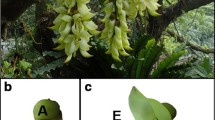Abstract
We studied pollination ecology of the sympatric palms Attalea allenii and Wettinia quinaria in a tropical rain forest in Colombia. Attalea has a subterranean stem and Wettinia is tall and arboreal. Both species have thermogenesis and short anthesis, and their floral scents differ in chemical composition. Inflorescences of both palms are visited by beetles, bees and flies. Pollination is diurnal, and is effected mostly by two species of Mystrops (Nitidulidae: Nitidulinae: Mystropini) each of them specific to one palm species. Both palms share few visitors and no pollinators. Differences in scent composition probably cause this isolation. We contrast their diurnal pollination with nocturnal pollination of other palms by mystropines in Amazonia and elsewhere, and relate it to precipitation regimes. The diurnal anthesis of A. allenii and W. quinaria and the diurnal activity of their specific mystropines probably coevolved as a response to the high, predominantly nocturnal rainfall in the Chocó.
Similar content being viewed by others
Author information
Authors and Affiliations
Corresponding author
Rights and permissions
About this article
Cite this article
Núñez, L.A., Bernal, R. & Knudsen, J.T. Diurnal palm pollination by mystropine beetles: is it weather-related?. Plant Syst. Evol. 254, 149–171 (2005). https://doi.org/10.1007/s00606-005-0340-6
Received:
Accepted:
Published:
Issue Date:
DOI: https://doi.org/10.1007/s00606-005-0340-6




